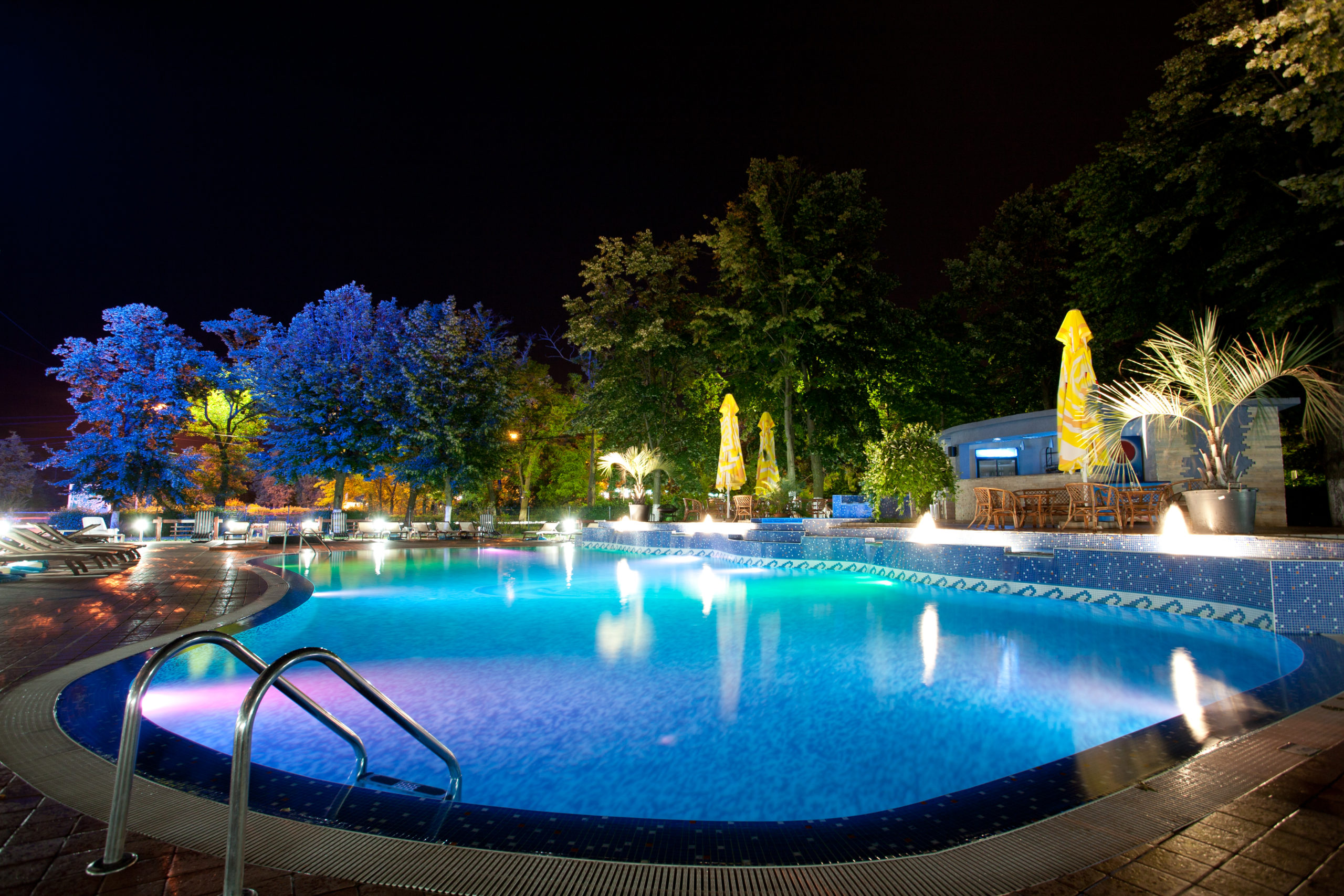Lighting is a critical element in modern pool design, transforming outdoor spaces into stunning visual landscapes while also ensuring safety for swimmers. Properly designed lighting can accentuate the architectural features of a pool, create ambiance, and extend the usability of the pool into the evening. Whether you’re looking to enhance your backyard with a resort-like feel or simply improve nighttime visibility, pool lighting is a powerful tool that combines form and function. For more information check out swimming pool builder
In this article, we will explore the various roles that lighting plays in pool design, focusing on its aesthetic appeal, its importance in maintaining safety, and how homeowners can make the most of lighting technology to create an inviting and secure pool environment.
1. Aesthetic Appeal: Creating Visual Drama and Ambiance
One of the primary roles of lighting in pool design is to elevate the overall aesthetics of the outdoor space. Pool lighting can be used to create a striking visual impact by highlighting the shape and structure of the pool, as well as the surrounding landscape.
a. Highlighting Pool Features
Lighting can bring out the best in your pool’s design, highlighting architectural elements like waterfalls, fountains, or custom tile work. Underwater lighting, for instance, casts a soft glow through the water, drawing attention to the pool’s depth, curves, and color. Different lighting placements can emphasize specific features, such as step lighting to showcase an elegant staircase, or edge lighting that traces the pool’s perimeter, giving it a modern, sleek look.
b. Ambient Lighting for Relaxation
Lighting plays a crucial role in creating the mood and atmosphere of an outdoor space. Whether you’re aiming for a calm and serene environment for nighttime relaxation or a lively space for entertaining guests, pool lighting allows you to control the vibe. Colored LED lights can be used to change the pool’s color depending on the occasion or mood, offering a dynamic and customizable aesthetic. A soft, warm glow encourages relaxation, while vibrant colors can bring energy to nighttime parties or gatherings.
c. Illuminating the Surrounding Landscape
Beyond the pool itself, lighting can enhance the overall outdoor experience by illuminating landscaping features such as trees, pathways, and seating areas. Using spotlights, uplights, or accent lighting on plants, pergolas, and outdoor furniture extends the design’s reach beyond the water and unifies the entire backyard space. This creates a cohesive environment where the pool seamlessly blends with the surrounding elements, making the backyard feel like a luxurious retreat.
2. Safety First: Ensuring Safe Nighttime Swimming
While lighting undoubtedly enhances the beauty of a pool area, its functional role in ensuring safety is paramount. A well-lit pool area helps prevent accidents and makes it safer for swimmers to enjoy the water at night.
a. Illuminating the Pool Perimeter
One of the most important safety features of pool lighting is illuminating the pool’s perimeter. This helps swimmers and visitors clearly see where the edge of the pool is, reducing the risk of accidental falls. Lighting around the pool deck also ensures that people walking around the pool can do so safely, especially in areas where the pool edge might not be immediately visible, such as in infinity pools or freeform pools.
b. Step and Entry Lighting
Steps, ladders, and other entry points into the pool are high-risk areas, especially at night. Adding step lighting or placing lights around entry points ensures that swimmers can safely enter and exit the pool without tripping or slipping. These lights should be soft and low-profile, bright enough to provide visibility but not so intense that they create glare or distraction.
c. Underwater Lighting for Depth Perception
Underwater lighting is crucial for enhancing safety during nighttime swimming. Pools without adequate underwater lighting can create disorienting shadows, making it difficult to judge depth and detect where the pool floor ends. Well-placed lights in the pool’s deep and shallow areas ensure that swimmers can see the water clearly, reducing the risk of diving into shallow water or swimming into walls.
d. Pathway and Deck Lighting
In addition to lighting the pool itself, illuminating pathways, stairs, and the pool deck is essential for guiding people safely to and from the pool area. Low-level path lighting can prevent trips or falls, while overhead lights or strategically placed spotlights can illuminate areas where people gather, such as seating areas or dining spaces near the pool.
3. Energy-Efficient Lighting Options
As pool lighting technology has advanced, energy efficiency has become an important consideration. Homeowners are increasingly opting for LED lighting and solar-powered lights, which offer a host of advantages over traditional incandescent bulbs.
a. LED Lighting
LED lights have revolutionized pool lighting due to their energy efficiency, longevity, and versatility. LED bulbs use significantly less electricity than incandescent lights, making them a more eco-friendly choice. Additionally, they last longer, meaning you won’t have to replace them as often. With the ability to change colors and brightness levels, LED lighting provides flexibility for homeowners who want to adjust the pool’s ambiance for different occasions.
b. Solar-Powered Lights
For homeowners seeking an even greener solution, solar-powered pool lights are a great option. Solar lights use the sun’s energy to charge during the day and automatically turn on at night. These lights are ideal for illuminating the pool deck or surrounding landscape without relying on electricity, making them a sustainable and cost-effective choice. However, their brightness may be less intense than wired options, so they’re best suited for ambient lighting rather than primary safety lighting.
4. Smart Lighting Controls: Convenience and Customization
Incorporating smart lighting systems into your pool design offers unparalleled convenience and customization. Many modern lighting systems can be controlled remotely via smartphone apps, allowing homeowners to adjust the brightness, color, and timing of their pool lights from anywhere.
a. Remote Control and Automation
With smart lighting, you can set your pool lights to turn on and off automatically at specific times, making it easy to create a consistent lighting routine. You can also remotely adjust the intensity or color of the lights to match the occasion. For example, you could dim the lights for a more relaxed evening or switch to a colorful light show for a party—all from the convenience of your phone.
b. Color-Changing Features
Many LED lighting systems come with color-changing capabilities, allowing you to cycle through different hues or create specific lighting schemes. For instance, you might choose a tranquil blue for late-night swims or vibrant red and green for a festive occasion. Some systems even allow you to sync the lights with music, creating a dynamic and immersive outdoor experience.
5. Incorporating Lighting into Pool Design
Effective pool lighting should be considered as early as possible during the design phase to ensure a harmonious integration with the pool’s structure and surrounding space. Here are some key considerations for incorporating lighting into your pool design:
a. Designing for Symmetry and Balance
Balance and symmetry are important when incorporating lighting into the pool design. Lighting should complement the pool’s shape and layout, with fixtures evenly distributed to avoid creating dark or overly bright areas. By considering the natural lines of the pool and surrounding landscape, you can achieve a balanced look that enhances the beauty of the space.
b. Choosing the Right Placement
Strategic placement is key to getting the most out of your pool lighting. For instance, underwater lights should be placed at even intervals to illuminate the pool uniformly, while deck and pathway lights should be spaced to provide consistent illumination without creating glare. Using recessed lighting in pool walls or steps helps keep the focus on the pool itself while still providing safety and ambiance.
c. Using Light to Create Depth
Lighting can also create a sense of depth and dimension in your outdoor space. For example, uplighting plants or placing spotlights on vertical surfaces like walls or tall trees can create a layered effect that makes the pool area feel larger and more dynamic.
Conclusion
Lighting plays an integral role in both the aesthetic and functional aspects of pool design. By carefully selecting and placing lights, homeowners can create a safe, inviting, and visually stunning pool environment that can be enjoyed day and night. From highlighting architectural features and landscaping to ensuring safe swimming after dark, the right lighting can transform a pool into a true backyard oasis. Whether you’re opting for energy-efficient LED systems or using smart technology for remote control, thoughtful lighting design is key to making the most of your pool experience.
Keep an eye for more news & updates on Discover Tribune!



